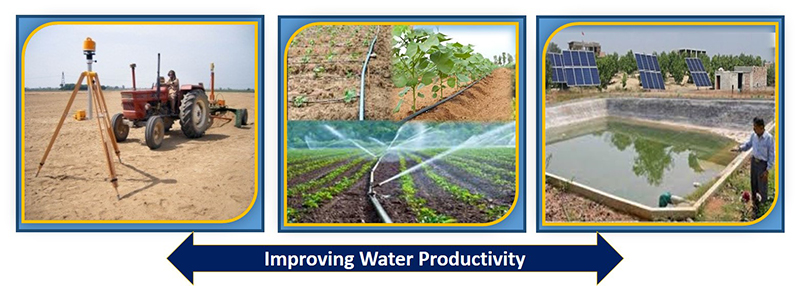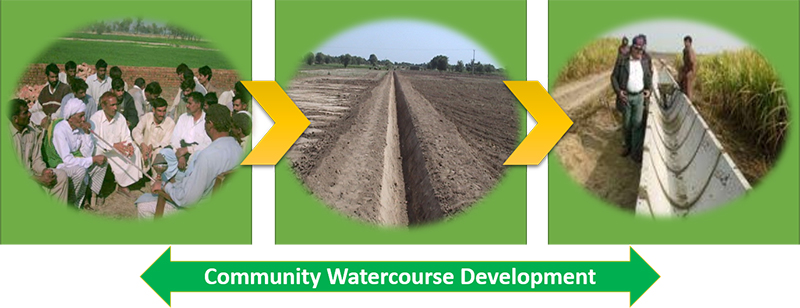Command Area Development (CAD) Component
|
The Jalalpur Irrigation Project (JIP) is situated along the right bank of the River Jhelum, covering the Jhelum and Khushab districts in Pakistan. It is designed as a non-perennial irrigation system aimed at irrigating approximately 169,000 acres of virgin land located in Pind Daden Khan and Khushab tehsils. The primary objective of the project is to foster the development of irrigated agriculture in the region. By harnessing the limited water resources available, the JIP seeks to transform cultural wasteland into productive agricultural areas. This initiative is expected to contribute to poverty alleviation by generating employment opportunities and maximizing farm profitability. The project entails the organization of 485 water users associations (WUAs), the construction of watercourses, LASER land leveling on 30,000 acres, installation of high-efficiency irrigation systems on 2,000 acres, and the construction of water storage ponds and solar-powered pumping stations to irrigate un-commanded areas in the outlet commands. Over a duration of four years (2019-20 to 2022-23), the JIP, with a total project cost of PKR 3,959.702 million (US$ 37.71 million), aims to promote sustainable agriculture and optimize the utilization of water resources for the benefit of the local communities in Jhelum and Khushab districts. ObjectiveThe key objectives of the Jalalpur Irrigation Project (JIP) in bullet point format:
|
Components of the Jalalpur Irrigation Project (JIP):
The Jalalpur Irrigation Project (JIP) encompasses several components that contribute to its overall objective of promoting irrigated agriculture and efficient water resource utilization. These components include:
- Organization of 485 water users associations (WUAs): The project aims to establish and organize WUAs, which are community-based organizations that play a vital role in managing water resources and ensuring equitable distribution among farmers.
- Development and construction of 485 watercourses: Construction of watercourses is an essential aspect of the project, as it involves the development of channels and infrastructure to deliver water from the main canal to the agricultural fields.
|
|
- LASER land leveling on 30,000 acres in watercourse commands: LASER land leveling is a technique used to precisely level agricultural land, resulting in more efficient water distribution and improved crop productivity.
- Installation of High-Efficiency Irrigation Systems on 2,000 acres: High-efficiency irrigation systems, such as drip irrigation or sprinkler systems, will be installed on a designated area to minimize water wastage and optimize water use in agricultural fields.
- Construction of 20 Water Storage Ponds and Solar Powered Pumping Stations for Irrigating Un-commanded Areas in the Outlet Commands: The project involves the construction of water storage ponds, which serve as reservoirs for storing water during periods of excess flow. Solar-powered pumping stations will also be installed to ensure a reliable water supply to un-commanded areas, thereby expanding the reach of irrigation.
These components collectively contribute to sustainable infrastructure development at the farm level, promoting efficient water utilization, and enhancing agricultural productivity in the project area. By implementing these measures, the JIP aims to alleviate poverty by generating employment opportunities and maximizing farm profitability while ensuring the long-term viability of the irrigation system.
 |
Gestation Period
The gestation period of the Jalalpur Irrigation Project (JIP) spans four years, from 2019-20 to 2022-23.
Financial Outlay of the Jalalpur Irrigation Project (JIP) is as follows:
- Total Project Cost: PKR 3,959.702 million (US$ 37.71 million)
- Asian Development Bank contribution: PKR 2,624.052 million (US$ 24.99 million)
- Punjab Government contribution: PKR 793.360 million (US$ 7.55 million)
- Farmers' contribution: PKR 542.290 million (US$ 5.16 million)
These funding sources collectively support the implementation of the JIP, with the Asian Development Bank, the Punjab Government, and the farmers providing financial support for the project's successful execution.
Project Area: Jhelum and Khushab Districts
The project area of the Jalalpur Irrigation Project (JIP) covers the Jhelum and Khushab districts in Pakistan. These districts are located along the right bank of the River Jhelum and encompass the areas where the project aims to develop irrigated agriculture on approximately 169,000 acres of virgin land in Pind Daden Khan and Khushab tehsils.

